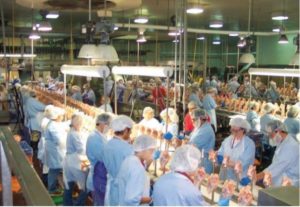
A rash of coronavirus outbreaks at dozens of meat packing plants across the nation is far more extensive than previously thought, according to an exclusive review of cases by USA TODAY and the Midwest Center for Investigative Reporting.
And it could get worse. More than 150 of America’s largest meat processing plants operate in counties where the rate of coronavirus infection is already among the nation’s highest, based on the media outlets’ analysis of slaughterhouse locations and county-level COVID-19 infection rates.
These facilities represent more than 1 in 3 of the nation’s biggest beef, pork and poultry processing plants. Rates of infection around these plants are higher than those of 75% of other U.S. counties, the analysis found.
And while experts say the industry has thus far maintained sufficient production despite infections in at least 2,200 workers in 48 plants, there are fears that the number of cases could continue to rise and that meat packing plants will become the next disaster zones.
“Initially our concern was long-term care facilities”. said Gary Anthone, Nebraska’s chief medical officer, in a Facebook Live video on Sunday. “If there’s one thing that might keep me up at night, it’s the meat processing plants and the manufacturing plants.”

But experts say there’s little risk of a dwindling protein supply because, given the choice between worker safety and keeping meat on grocery shelves, the nation’s slaughterhouses will choose to produce food.
“If this goes on for a long time, there is a reality of a shortage,” said Joshua Specht, an assistant professor of history at the University of Notre Dame who studies the meat industry. “The politics of this could play out that they reopen at enormous risks to workers, rather than face an actual shortage… I wouldn’t bet against that.”
The meat packing industry was already notorious for poor working conditions even before the coronavirus pandemic. Meat and poultry employees have among the highest illness rates of all manufacturing employees and are less likely to report injuries and illness than any other type of worker, federal watchdog reports have found.
And the plants have been called out numerous times for refusing to let their employees use the bathroom, even to wash their hands — one of the biggest ways to reduce the spread of the coronavirus.
Amplifying the danger is that, in many places, meat processing companies are largely on their own to ensure an outbreak doesn’t spread across their factory floors.
Factory workers, unions, and even managers say the federal government — including the U.S. Centers for Disease Control and Prevention and the Occupational Safety and Health Administration — has done little more than issue non-enforceable guidance. On its website, for example, the CDC has released safety guidelines for critical workers and businesses, which primarily promote common sense measures of sanitization and personal distancing.
State health departments have also taken a backseat role in all but a few places.
A bill introduced in the U.S. House of Representatives on Tuesday would require OSHA to issue enforceable safety standards to protect workers from COVID-19. A day earlier, 32 Democratic and two independent U.S. senators sent their concerns in a letter to the Trump administration, asking what was being done to protect food workers and the supply chain.
“Breakdowns in the food supply chain could have significant economic impacts for both consumers and agricultural producers,” the letter read. “It is also imperative that precautions are taken to ensure the stability and safety of our food supply.”
But rather than increase safety and oversight, the U.S. Department of Agriculture relaxed it in the midst of the pandemic. Just this month, the agency allowed 15 poultry plants to exceed federal limits on how many birds workers can process in a minute.
That’s more than in any previous month in the waiver program’s history. Several worker protection agencies have found that increasing line speeds causes more injuries.
And it could lead to more infections, the United Food and Commercial Workers International Union said in a statement: “These waivers guarantee that workers are more crowded along a meatpacking line and more workers are put at risk of either catching or spreading the virus.”
Most of the plants that received waivers are owned by Tyson Foods and Wayne Farms, according to a department record. One of them — a Wayne Farms facility in Albertville, Alabama — disclosed this week that 75 of its workers tested positive and one died. The plant will slow production to improve safety, it told AL.com.
“This is so dangerous for workers and the public,” Debbie Berkowitz, who spent six years as chief of staff and senior policy advisor at OSHA and is now director of the National Employment Law Project’s worker health and safety program.
Berkowitz said she’s never seen anything like the recent flurry of approvals. “They did this behind closed doors with no input by the public and with no consideration to the impact on food or workers’ safety.”
A spokesperson with the Food Safety and Inspection Service, the USDA agency that grants the waivers, said the agency has stopped accepting additional waiver requests.
Companies say they are taking steps to keep workers safe from outbreaks as they continue to feed the nation.
After the coronavirus sickened nearly 200 workers and killed two at a Tyson plant in Iowa, the company responded by making sweeping safety improvements at all its facilities, said Worth Sparkman, a company spokesperson.
Tyson installed plastic barriers between workers on the lines, allowed more time between shifts and removed chairs in break rooms to keep workers at a safe distance, Sparkman said.
“At all locations we’re working to educate our team members and reinforce the importance of social distancing, wearing protective facial coverings and frequent hand washing outside of work as well,” he said. “This is especially important in locations where there is community spread occurring.”
Tyson reopened its Iowa plant on Tuesday after having closed it April 6 to contain the outbreak.
But meat processing workers elsewhere remain fearful for their safety.
A 50-year-old employee named John at Smithfield’s Sioux Fall plant told USA TODAY that there’s no way to stay six feet apart from coworkers on the production line, in the cafeteria or in the locker room. The employee asked to use only his first name for fear that speaking out would cost him his job.
As people around him at the plant became infected with COVID-19, John said, he started feeling sick and went to get his temperature checked, thinking he needed to leave. But he was stopped, he said.
“They told me I was OK and I needed to work,” said John, who has worked at the plant for a decade. “I said nope, and I came home.”
In early April, he learned he had tested positive for COVID-19.
“Those people don’t care about us,” John said. “If you die, they’ll just replace you tomorrow.”
Plants close, production plummets
By the time it closed its doors on April 12, Smithfield’s Sioux Falls plant had more than 200 confirmed cases of COVID-19. In the days since then, the case count has swelled to nearly 900, including workers and those they’ve interacted with, making it the biggest single cluster of COVID-19 infections in the nation.

CDC employees are touring the plant to develop a reopening plan expected to be released this week.
But it’s not just Smithfield. As of Tuesday night, coronavirus infections had spread in at least 48 U.S. meat packing plants, sickening more than 2,200 people and killing 17, USA TODAY and the Midwest Center for Investigative Reporting found. The outbreaks also have prompted the closure of at least 17 facilities, including that of the JBS pork plant in Worthington, Minnesota, on Monday.
The Worthington JBS is among the 153 meat processing plants that USA TODAY and the Midwest Center for Investigative Reporting identified as operating in counties with a high rate of coronavirus. Any rate above one infection per 1,000 people puts a county in the top 25% of U.S. counties reporting COVID-19 infection rates.
Other plants on the list include the Tyson pork-processing facility in Columbus Junction, Iowa, where 186 workers fell ill and two died after COVID-19 swept through the factory.
The Tyson plant is located in Louisa County, where 19 out of every 1,000 people have tested positive for the novel coronavirus. It’s the highest rate of any county with a large meat processor.
USA Today


